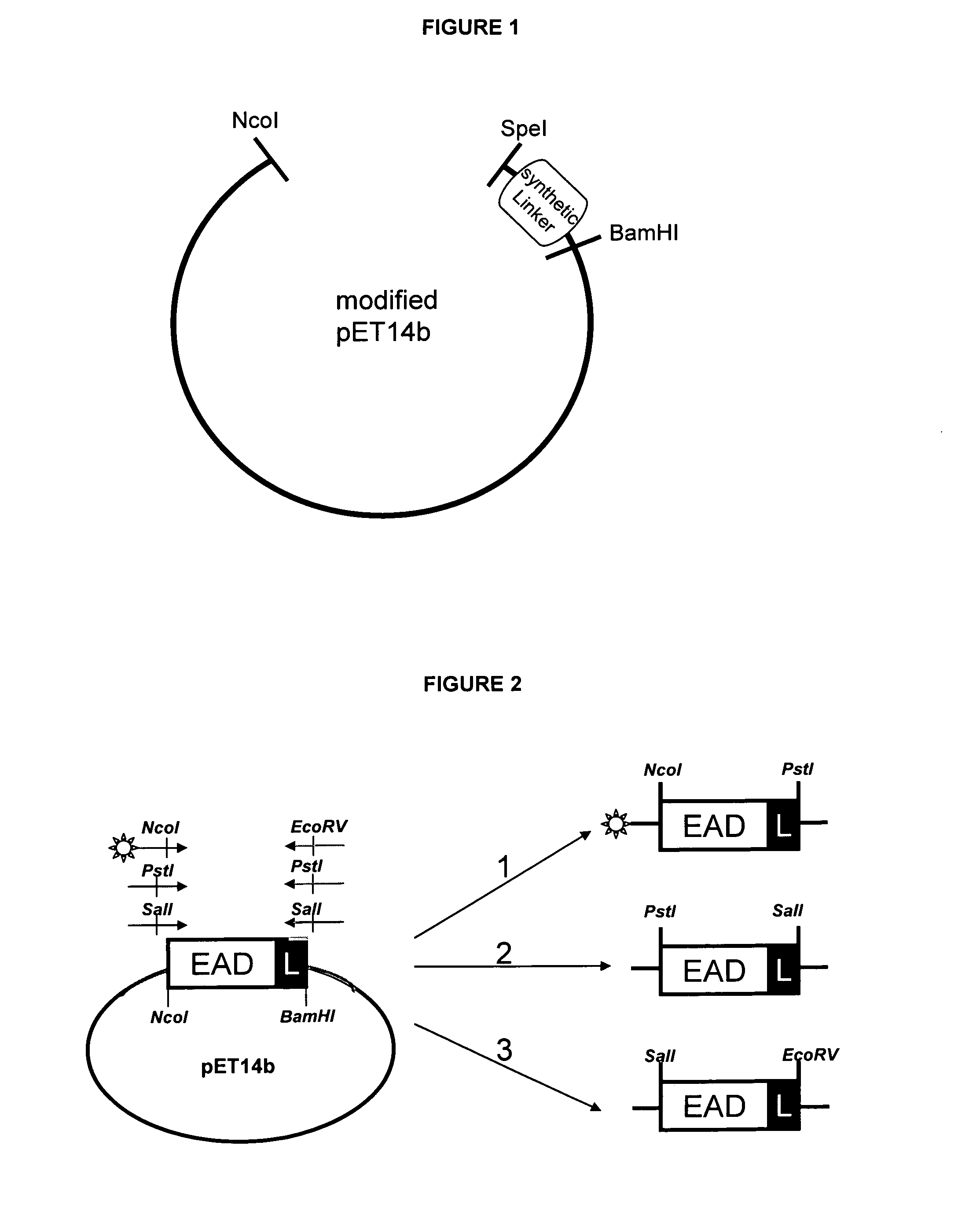Methods of generating and screening for lytic chimeric polypeptides
a chimeric polypeptide and polypeptide technology, applied in the field of generating and screening for chimeric polypeptides, can solve the problems of poor stability of enzymes, no evidence of efficacy on living cells under application-relevant conditions, and the difficulty of increasing the number of antibiotic resistant bacteria, so as to improve the survival rate and reduce the risk of resistance development, the effect of fast onset of action
- Summary
- Abstract
- Description
- Claims
- Application Information
AI Technical Summary
Benefits of technology
Problems solved by technology
Method used
Image
Examples
example 1
Cloning of Selected Domains
[0104]Table 1 shows selected domains used for library construction.
TABLE 1Selected domains with description of protein source, domain borders of theamino acid sequence and enzymatic specificity of EADs.SEQ IDProtein sourceNO:DomainDomain bordersSpecificityEndolysin, Ply5111EAD5111-195Amidase 2Endolysin, Ply5111CBD511194-141 + LinsynEndolysin, Ply5002EAD5001-154VanYEndolysin, Ply5002CBD500148-189 + LinsynEndolysin, PlyP403EADP401-225ChalaropsisLysozymeEndolysin, PlyP403CBDP40A: 226-344 + LinsynB: 192-344 + LinsynC: 192-344Endolysin, PlyP354EADP351-150VanYEndolysin, PlyP354CBDP35140-291 + LinsynEndolysin, PlyB0545EADB0541-194Amidase 3Endolysin, PlyPSA6EADPSA1-182Amidase 3Endolysin, Ply0067CBD006157-235 + LinsynEndolysin, PlyB0258CBDB025127-276 + LinsynLytic Tail protein,9EADgp29641-795 + LinsynNlpC / p60gp29 of P100(CHAP)Autolysin,10MurAA: 52-327LysozymL. monocytogenesB: 142-327type 2Autolysin,11IspC1-226LysozymL. monocytogenestype 2Bacteriocin,12Mutanolysin 7...
example 2
Generation of Ligatable, Position Specific PCR Fragments
[0108]For introduction of the position specific restriction sites, the domains were amplified via PCR by position specific primer combinations (see FIG. 2 and Table 1). As PCR templates served the domains cloned in pET14b. FIG. 3 shows exemplarily the PCR products for position 1, 2 and 3 of EAD500.
TABLE 2Position specific primer pairs.Pos. 1forward: B-5′-GTTTAACTTTAAGAAGGAGATATACCATGGCG-3′reverse: 5′-CCTTTCGGGCTTTGTTACTGCAGGGATCC-3′Pos. 2forward: 5′-GTTTAACTTTAAGAAGGAGACTGCAGATGGCG-3′reverse: 5′-CCTTTCGGGCTTTGTTAGTCGACGGATCC-3′Pos. 3forward: 5′-GTTTAACTTTAAGAAGGAGAGTCGACATGGCG-3′orforward: B-5′-GTTTAACTTTAAGAAGGAGAGTCGACATGGCG-3′reverse: 5′-CCTTTCGGGCTTTGTTAGATATCGGATCC-3′B: 5′-attached Biotin-tagCCATGG: Ncol-siteCTGCAG: Pstl-siteGTCGAC: Sall-siteGATATC: EcoRV-site
[0109]PCR for domain position 3 was performed twice: with non-biotinylated forward primer and with biotinylated forward primer. PCR products for position 1 and withou...
example 3
Test for Activity of Cloned Domains
[0110]All cloned domains were tested for domain activity. EADs were tested for Listeria lytic activity, CBDs were tested for Listeria binding activity.
3-1. Testing Listeria Lytic Activity of EADs
[0111]E. coli HMS (174) clones containing the pET14bEAD constructs were spotted on LB Top Agar plates containing IPTG for the induction of protein expression, ampicillin for the plasmid selection pressure and 120 μl heat inactivated Listeria cells of Listeria monocytogenes EGDe (J.Kreft), serotype 1 / 2a. Each domain was spotted and incubated at 30° C. and afterwards at room temperature. In case of Listeria lysis, the spotted E. coli clone is surrounded by a clearing in the agar. As a result, all tested EADs show lysis on Listeria monocytogenes EGDe.
[0112]Generation of heat inactivated Listeria cells: Listeria were grown in Tryptose Broth (TB), 30° C., shaking until OD=1. After harvesting, the cells were resuspended in 1 / 200 volume PBST (1×PBS+0.1% Tween) pH ...
PUM
| Property | Measurement | Unit |
|---|---|---|
| Magnetism | aaaaa | aaaaa |
Abstract
Description
Claims
Application Information
 Login to View More
Login to View More - R&D
- Intellectual Property
- Life Sciences
- Materials
- Tech Scout
- Unparalleled Data Quality
- Higher Quality Content
- 60% Fewer Hallucinations
Browse by: Latest US Patents, China's latest patents, Technical Efficacy Thesaurus, Application Domain, Technology Topic, Popular Technical Reports.
© 2025 PatSnap. All rights reserved.Legal|Privacy policy|Modern Slavery Act Transparency Statement|Sitemap|About US| Contact US: help@patsnap.com



